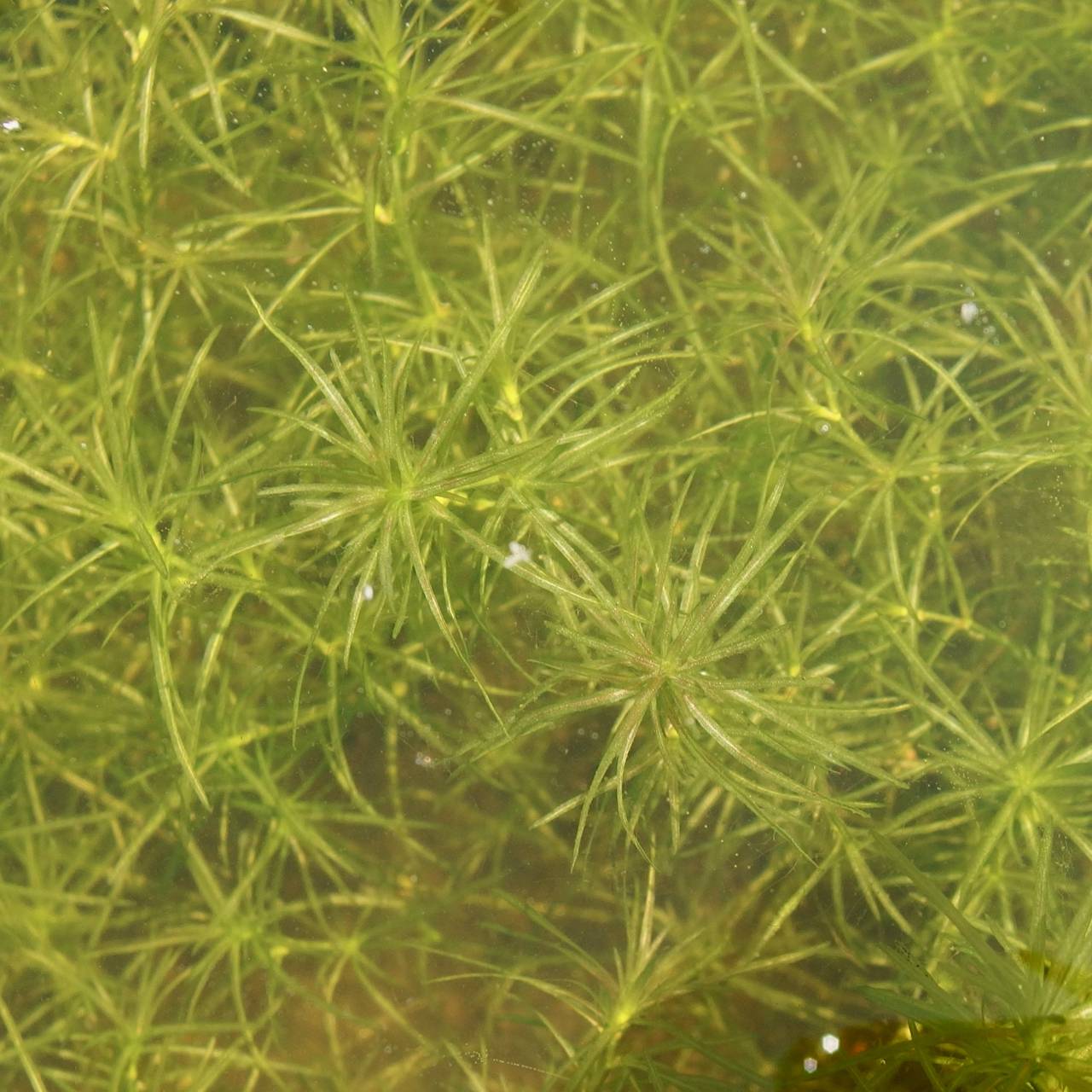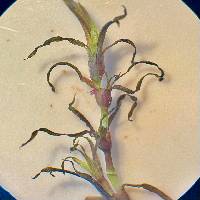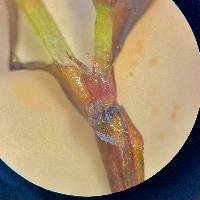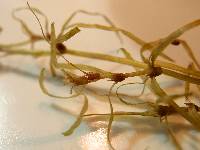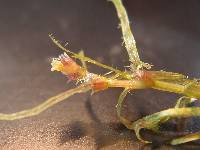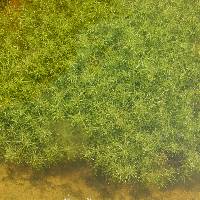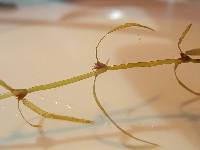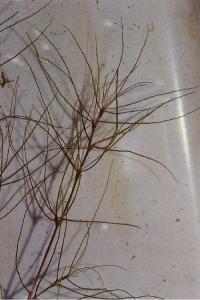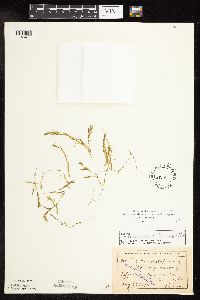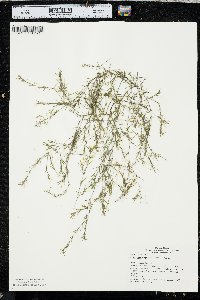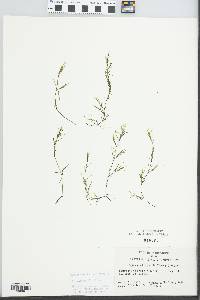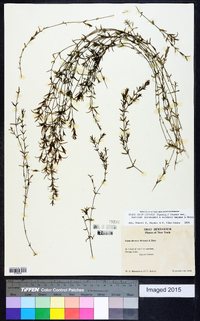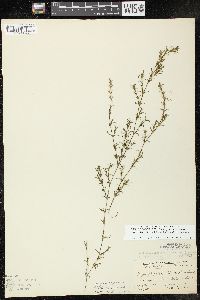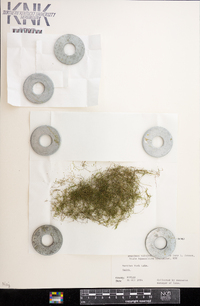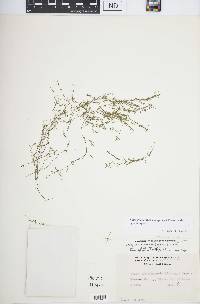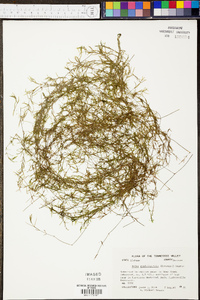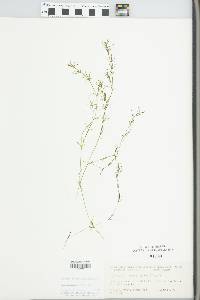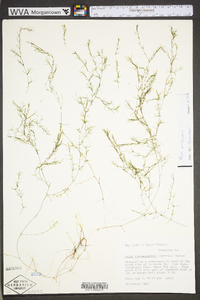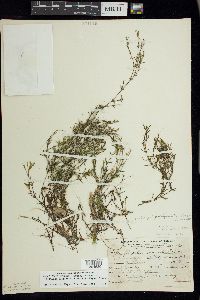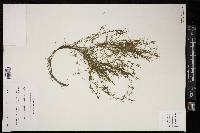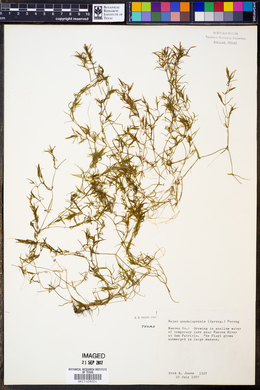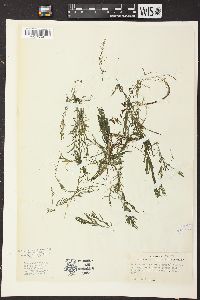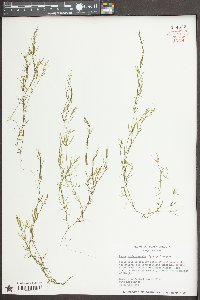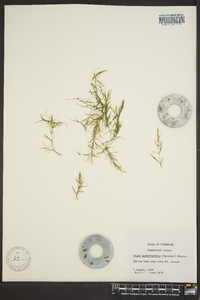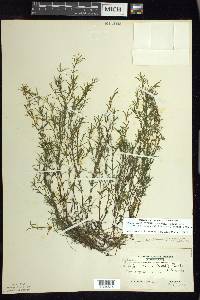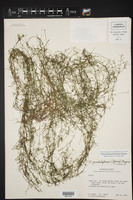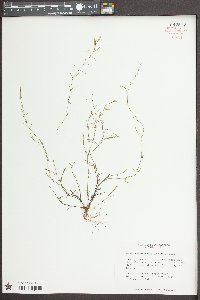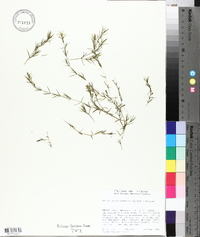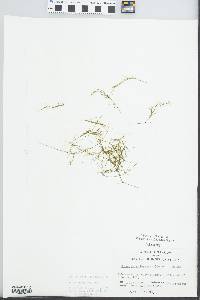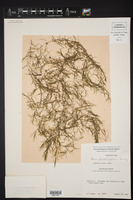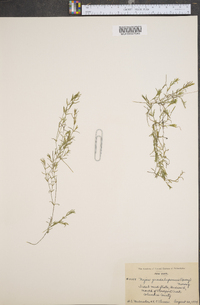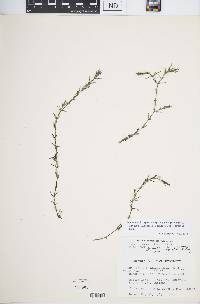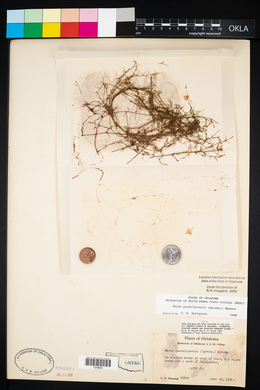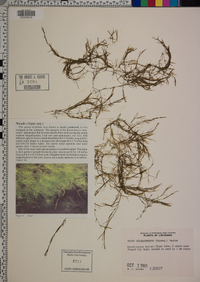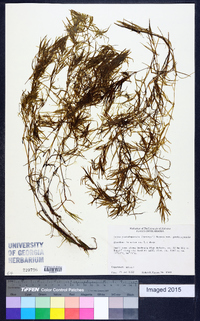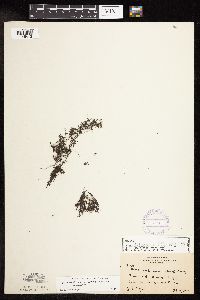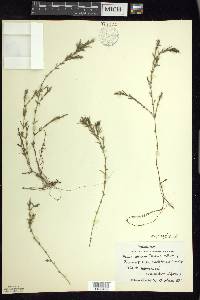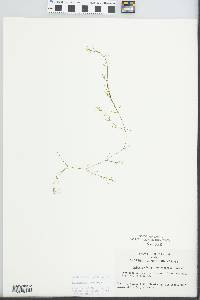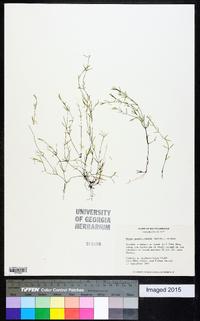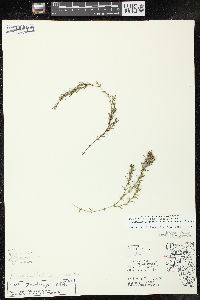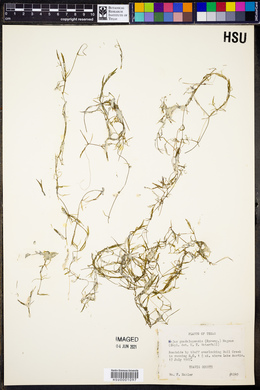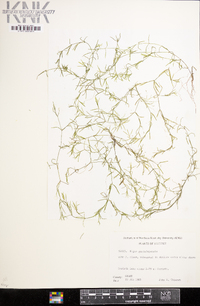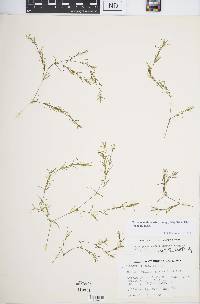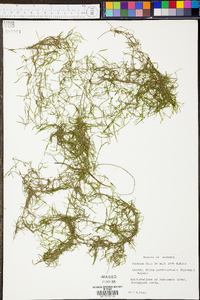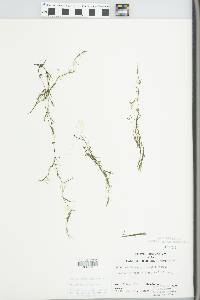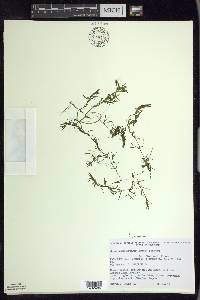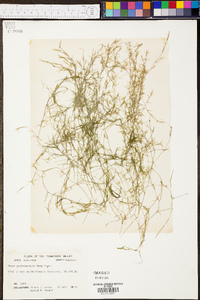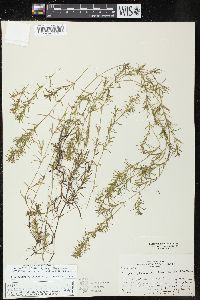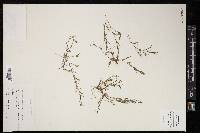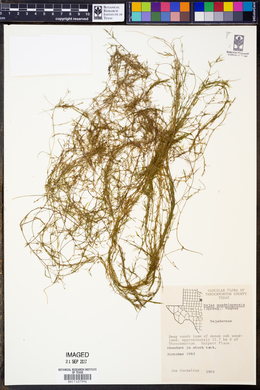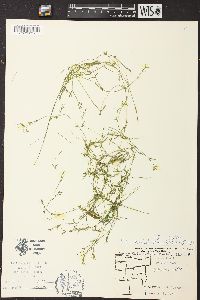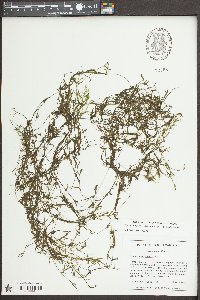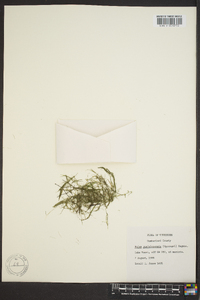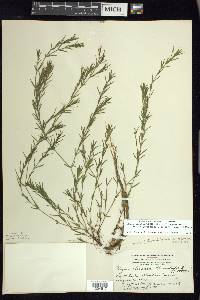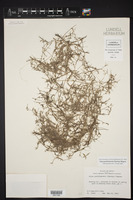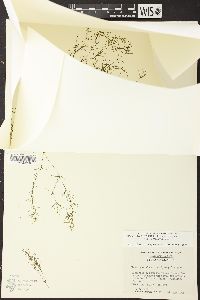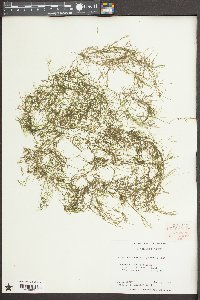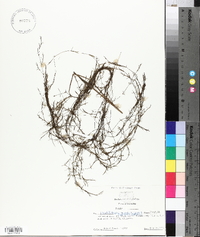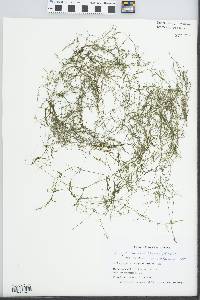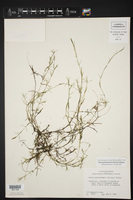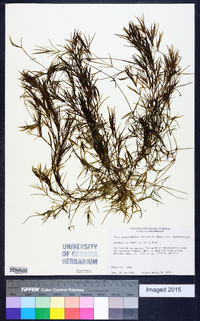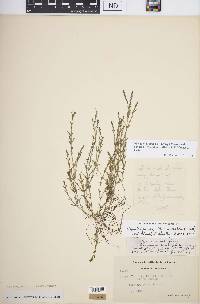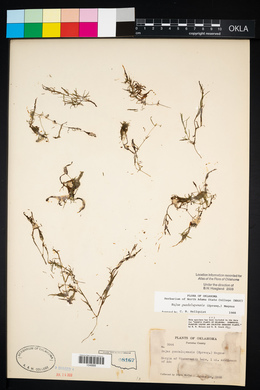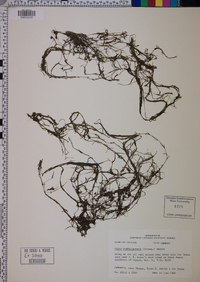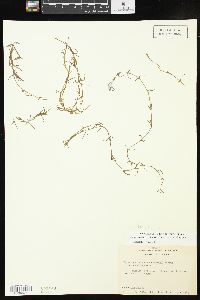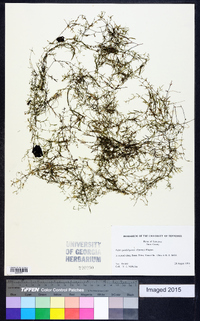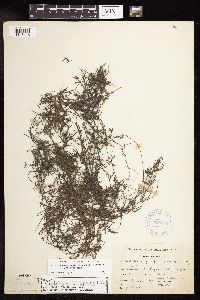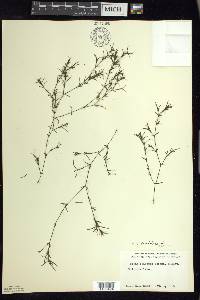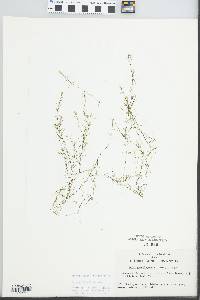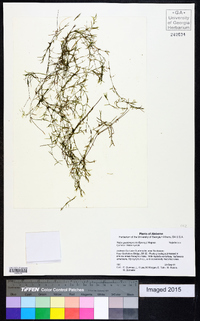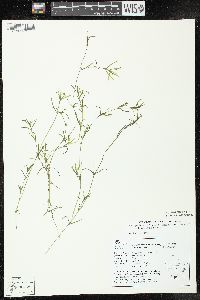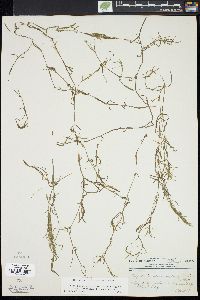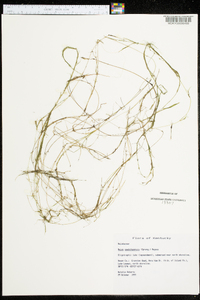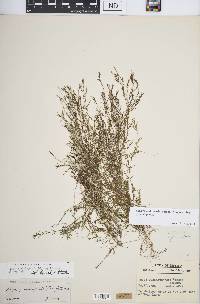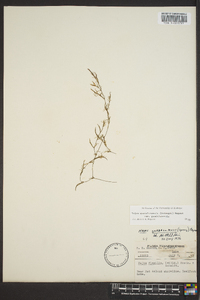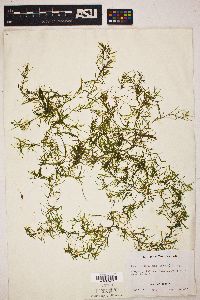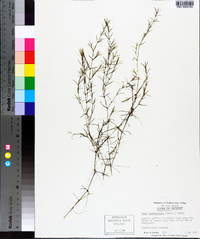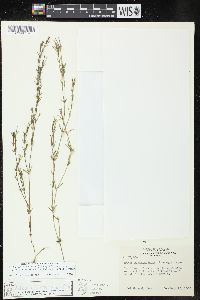Najas guadalupensis
|
|
|
|
Family: Hydrocharitaceae
Guadalupe Waternymph, more...southern waternymph, common waternymph
[Najas flexilis var. fusiformis] |
Stems often profusely branched distally, 11--90 cm ´ 0.1--2 mm; internodes 0.1--9 cm, without prickles. Leaves spreading with age, 0.3--3.3 cm, lax in age; sheath 1--3.4 mm wide, apex rounded to truncate; blade 0.2--2.1 mm wide, margins minutely serrulate, teeth 18--100 per side, apex rounded to truncateslightly auriculate, with 1--3 teeth, teeth unicellular; midvein without prickles abaxially. Flowers 1--3 per axil, staminate and pistillate on same plants. Staminate flowers in distal axils, 1.5--3 mm; involucral beaks 4-lobed, 0.2--1.3 mm; anther 1- or 4-loculed, 1--1.7 mm. Pistillate flowers in proximal axils, 1.5--4 mm; styles 0.3--1.5 mm; stigmas 4-lobed. Seeds not recurved, yellowish white with purple tinge, fusiform, 1.2--3.8 ´ 0.4--0.8 mm, apex with style situated at center; testa dull, 3 cell layers thick, pitted; aeroleareoles regularly arranged in 20--60 longitudinal rows, not ladderlike, 4--6-angled, longer than broad, end walls not raised. 2n = 12, 36, 42, 48, 54, 60. By having unicellular teeth on the leaf margin, Najas guadalupensis resembles N. flexilis and N. graminea. The seeds of N. guadalupensis are pitted; those of N. flexilis are smooth. The sheaths of N. guadalupensis are rounded to slightly auriculate; those of N. graminea are deeply auriculate.
Annual submersed aquatic herb to 0.9 m long Leaves: opposite, stalkless, 0.3 - 3.3 cm long, 0.2 - 2 mm wide, widening to a 1 - 3.4 mm sheath at base, linear with a rounded to abruptly pointed tip, with 20 to 100 tiny teeth per side (may require hand lens). Flowers: either male or female, found on the same plant (monoecious), borne one to three in leaf axils, green, tiny. The 1.5 - 3 mm long male flowers have four-lobed beaks, and the 1.5 - 4 mm long female flowers have four-lobed stigmas and stout styles. Fruit: achene-like, yellowish white with a hint of purple, 1.2 - 3.8 mm long, 0.4 - 0.8 mm wide, spindle-shaped (fusiform), dull, pitted in ten to 60 rows. Stems: slender, highly branched, 11 cm - 0.9 m long, 0.1 - 2 mm wide, rooting at the nodes. Similar species: Najas flexilis and Najas guadalupensis both have finely toothed leaves that can usually only be seen using a hand lens. Najas flexilis differs by having glossy seeds and leaves that taper to a narrow pointed tip. Najas guadalupensis ssp. guadalupensis is distinguished from other subspecies by having a style shorter than 0.5 mm and seeds with only ten to twenty rows of pits. Flowering: September Habitat and ecology: Occasional in shallow water of ponds and lakes. Occurence in the Chicago region: native Etymology: Najas comes from the Greek name for a river nymph, naias. Guadalupensis means "from Guadalupe Island, Mexico." Author: The Morton Arboretum FNA 2000, Jepson 2012 Duration: Annual Nativity: Native Lifeform: Forb/Herb General: Herbaceous, aquatic annuals, stems very slender and thread-like, to 90 cm long and 0.1-2 mm wide, the internodes 0.1-9 cm long, submerged or floating and often profusely branched distally, the surfaces without prickles, green to tan or dark brown in color. Leaves: Linear and thread-like, spreading and lax with age, 0.3-3.3 cm long and 0.2-2.1 mm wide, margins minutely serrulate, with 18-100 teeth per side, the midveins without prickles abaxially, apices rounded to truncate and slightly auriculate with 1-3 teeth, the teeth unicellular, the blades with sheaths 1-3.4 mm wide. Flowers: Generally 1-3 per axil, with staminate and pistillate flowers on same plants; staminate flowers 1.5-3 mm long, with 4-lobed involucral beaks, these 0.2-1.3 mm long, anthers 1- or 4-loculed, pistillate flowers 1-1.7 mm long, 1.5-4 mm long, styles 0.3-1.5 mm long, stigmas 4-lobed, staminate flowers borne in distal axils, pistillate flowers borne in proximal axils. Fruits: Seeds yellowish white with a purple tinge, fusiform, 1.2-3.8 mm long and 0.4-0.8 mm wide, not recurved, apices with styles situated at the center, the testa dull, 3 cell layers thick, pitted, areoles regularly arranged in 20-60 longitudinal rows, not ladd Ecology: Found from 4,000-6,000 ft (1219-1829 m); flowering August-October Distribution: Widespread throughout the United States. Ethnobotany: Unknown. Etymology: Najas comes from the Greek Naias, a water nymph, and guadalupensis means of or from Guadalupe Mountain. Synonyms: Numerous, see Tropicos Editor: LCrumbacher2012 Monoecious; stems profusely branched, 1-8 dm; lvs 0.5-3 cm נ0.2-2 mm, spreading, not so sharply pointed as in our other spp., with sloping shoulders at the base, minutely serrulate with 20-100 unicellular teeth per side; anthers dithecal, with 4 microsporangia; style apical; seeds 1.2-2.5 mm, purple-tinged, fusiform, pitted, the areolae 4-6-angled, about as long (0.08-0.1 mm) as wide, in 20-40 rows; 2n=12, 36, 48, 54, 60. Widespread in N. and S. Amer., n. to Me., s. Que., Man., Alta., and Wash. The widespread var. guadalupensis, slender, with stems 0.2-1 mm thick, and with 50-100 teeth on each side of the lf, tends to give way at the n. to var. olivacea (Rosend. & Butters) R. R. Haynes, which occurs from N.Y. and s. Que. to n. Ind., n. Io., and s. Man., and is stouter, with stems mostly 1-2 mm thick, and with 20-40 teeth per side of the lf. (N. olivacea) Gleason, Henry A. & Cronquist, Arthur J. 1991. Manual of vascular plants of northeastern United States and adjacent Canada. lxxv + 910 pp. ©The New York Botanical Garden. All rights reserved. Used by permission. |
|
|
|

